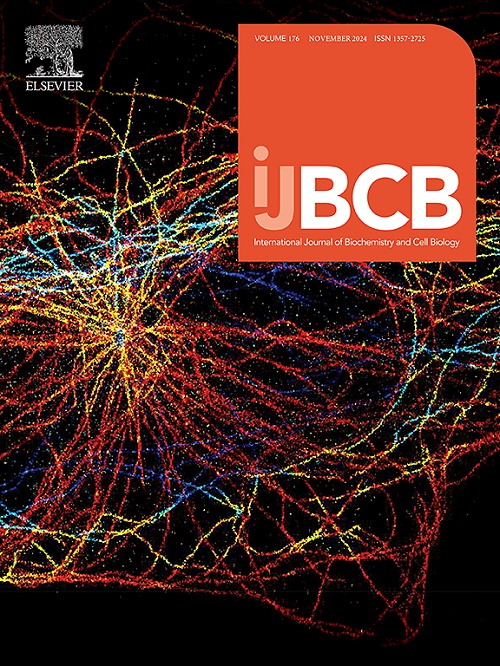Unveiling a novel signalling pathway involving NRF2 and PGAM5 in regulating the mitochondrial unfolded protein response in stressed cardiomyocytes
IF 2.8
3区 生物学
Q2 BIOCHEMISTRY & MOLECULAR BIOLOGY
International Journal of Biochemistry & Cell Biology
Pub Date : 2024-11-26
DOI:10.1016/j.biocel.2024.106704
引用次数: 0
Abstract
The mitochondrial unfolded protein response (UPRmt) is a conserved signalling pathway that initiates a specific transcriptional programme to maintain mitochondrial and cellular homeostasis under stress. Previous studies have demonstrated that UPRmt activation has protective effects in the pressure-overloaded human heart, suggesting that robust UPRmt stimulation could serve as an intervention strategy for cardiovascular diseases. However, the precise mechanisms of UPRmt regulation remain unclear. In this study, we present evidence that the NRF2 transcription factor is involved in UPRmt activation in cardiomyocytes during conditions of mitochondrial stress. Silencing NRF2 partially reduces UPRmt activation, highlighting its essential role in this pathway. However, constitutive activation of NRF2 via inhibition of its cytosolic regulator KEAP1 does not increase levels of UPRmt activation markers, suggesting an alternative regulatory mechanism independent of the canonical KEAP1-NRF2 axis. Further analysis revealed that NRF2 likely affects UPRmt activation through its interaction with PGAM5 at the mitochondrial membrane. Disruption of PGAM5 in cardiomyocytes subjected to mitochondrial stress reduces the interaction between PGAM5 and NRF2, enhancing nuclear translocation of NRF2 and significantly upregulating the UPRmt in an NRF2-dependent manner. This NRF2-regulated UPRmt amplification improves mitochondrial respiration, reflecting an enhanced capacity for cardiomyocytes to meet elevated energetic demands during mitochondrial stress. Our findings highlight the therapeutic potential of targeting the NRF2-PGAM5-KEAP1 signalling complex to amplify the UPRmt in cardiomyocytes for cardiovascular and other diseases associated with mitochondrial dysfunction. Future studies should aim to elucidate the mechanisms via which NRF2 enhances the protective effects of UPRmt, thereby contributing to more targeted therapeutic approaches.
揭示一种涉及NRF2和PGAM5调节应激心肌细胞线粒体未折叠蛋白反应的新信号通路。
线粒体未折叠蛋白反应(UPRmt)是一个保守的信号通路,它启动一个特定的转录程序来维持线粒体和细胞在压力下的稳态。先前的研究表明,UPRmt激活对压力过载的人类心脏具有保护作用,这表明强大的UPRmt刺激可以作为心血管疾病的干预策略。然而,UPRmt监管的确切机制仍不清楚。在这项研究中,我们提出了NRF2转录因子参与线粒体应激条件下心肌细胞UPRmt激活的证据。沉默NRF2部分减少UPRmt的激活,突出其在该途径中的重要作用。然而,通过抑制其胞质调节因子KEAP1来激活NRF2并不会增加UPRmt激活标记物的水平,这表明存在独立于典型的KEAP1-NRF2轴的另一种调节机制。进一步分析表明,NRF2可能通过与线粒体膜上的PGAM5相互作用影响UPRmt的激活。线粒体应激下心肌细胞中PGAM5的破坏减少了PGAM5与NRF2之间的相互作用,增强了NRF2的核易位,并以NRF2依赖的方式显著上调了UPRmt。这种nrf2调节的UPRmt扩增改善了线粒体呼吸,反映了心肌细胞在线粒体应激期间满足能量需求的能力增强。我们的研究结果强调了靶向NRF2-PGAM5-KEAP1信号复合物以扩增心肌细胞中的UPRmt对心血管和其他与线粒体功能障碍相关的疾病的治疗潜力。未来的研究应旨在阐明NRF2增强UPRmt保护作用的机制,从而有助于更有针对性的治疗方法。
本文章由计算机程序翻译,如有差异,请以英文原文为准。
求助全文
约1分钟内获得全文
求助全文
来源期刊
CiteScore
8.10
自引率
0.00%
发文量
124
审稿时长
19 days
期刊介绍:
IJBCB publishes original research articles, invited reviews and in-focus articles in all areas of cell and molecular biology and biomedical research.
Topics of interest include, but are not limited to:
-Mechanistic studies of cells, cell organelles, sub-cellular molecular pathways and metabolism
-Novel insights into disease pathogenesis
-Nanotechnology with implication to biological and medical processes
-Genomics and bioinformatics

 求助内容:
求助内容: 应助结果提醒方式:
应助结果提醒方式:


